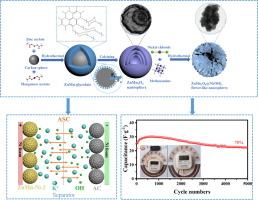高性能混合超级电容器用多壳ZnMn2O4空心spheres@Ni(OH)2纳米片的制备
IF 6.3
2区 材料科学
Q2 CHEMISTRY, PHYSICAL
引用次数: 0
摘要
本文以胶体碳球为模板,采用混合溶剂热法制备了多壳ZnMn2O4空心纳米球。随后,通过二次水热法在ZnMn2O4纳米球表面密集生长一层Ni(OH)2纳米片,得到异质结构纳米花状ZnMn2O4@Ni(OH)2电极材料。ZnMn2O4@Ni(OH)2通过多壳ZnMn2O4纳米球作为“电荷存储”和Ni(OH)2纳米片作为“电荷换能器”快速将电荷引入ZnMn2O4纳米球的协同机制显示出高比电容。所得ZnMn2O4@Ni(OH)2电极材料在电流密度为1 a g−1时的比电容为816.36 F g−1,高于单个ZnMn2O4空心纳米球和Ni(OH)2纳米片。将ZnMn2O4@Ni(OH)2纳米花与活性炭相结合,制备了不对称超级电容器器件。该器件在功率密度为3240 W·kg - 1时具有74.8 Wh·kg - 1的高能量密度,在5000次循环后具有75% %的长循环寿命。ZnMn2O4@Ni(OH)2电极材料具有简单的合成路线和优异的性能,在未来的储能应用中具有很强的潜力。研究结果为过渡金属氧化物/氢氧化物的异质生长提供了未来具有优异电化学性能的储能装置。本文章由计算机程序翻译,如有差异,请以英文原文为准。


Preparation of multi-shelled ZnMn2O4 hollow spheres@Ni(OH)2 nanosheets for high-performance hybrid supercapacitors
Herein, multi-shelled ZnMn2O4 hollow nanospheres were synthesized via a mixed solvothermal method using colloidal carbon spheres as templates. Subsequently, a layer of Ni(OH)2 nanoflakes was densely grown on the surface of the ZnMn2O4 nanospheres through a secondary hydrothermal process, yielding a heterostructure nanoflower-like ZnMn2O4@Ni(OH)2 electrode material. ZnMn2O4@Ni(OH)2 shows high specific capacitance through the synergistic mechanism that the multi-shelled ZnMn2O4 nanospheres act as “charge storage” and the Ni(OH)2 nanosheets act as “charge transducers” to quickly introduce charges into the ZnMn2O4 nanospheres. The resulting ZnMn2O4@Ni(OH)2 electrode material exhibits a specific capacitance of 816.36 F g−1 at a current density of 1 A g−1, which is higher than that of individual ZnMn2O4 hollow nanospheres and Ni(OH)2 nanoflakes. An asymmetric supercapacitor device was fabricated by integrating the ZnMn2O4@Ni(OH)2 nanoflowers with activated carbon. The device demonstrated a high energy density of 74.8 Wh·kg−1 at a power density of 3240 W·kg−1 and a long cycle life of 75 % capacitance retention after 5000 cycles. The simple synthesis route and excellent performance of the ZnMn2O4@Ni(OH)2 electrode material show strong potential for future energy storage applications. The results provide the future energy-storage devices with excellent electrochemical properties by the hetero-growth of transitional metal oxides/hydroxides.
求助全文
通过发布文献求助,成功后即可免费获取论文全文。
去求助
来源期刊

Applied Surface Science
工程技术-材料科学:膜
CiteScore
12.50
自引率
7.50%
发文量
3393
审稿时长
67 days
期刊介绍:
Applied Surface Science covers topics contributing to a better understanding of surfaces, interfaces, nanostructures and their applications. The journal is concerned with scientific research on the atomic and molecular level of material properties determined with specific surface analytical techniques and/or computational methods, as well as the processing of such structures.
 求助内容:
求助内容: 应助结果提醒方式:
应助结果提醒方式:


